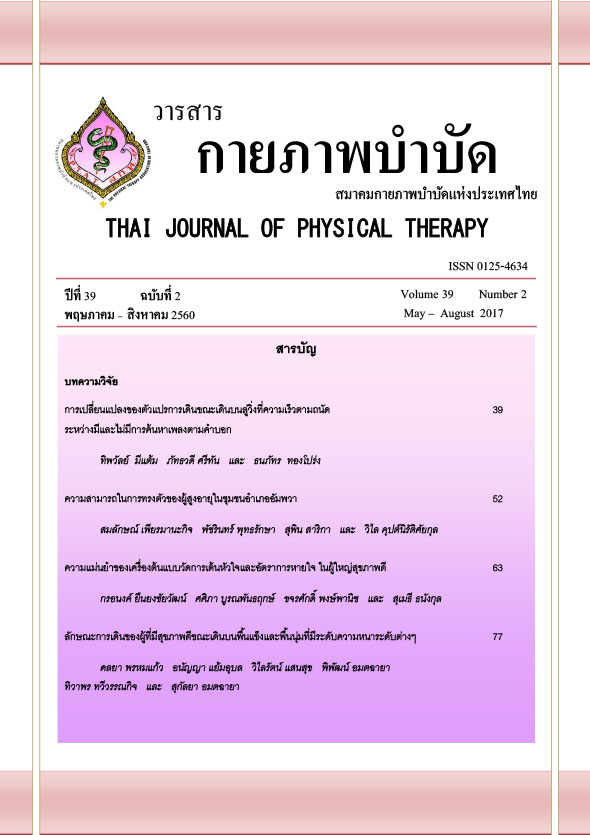ความแม่นยำของเครื่องต้นแบบวัดการเต้นหัวใจและอัตราการหายใจ ในผู้ใหญ่สุขภาพดี
Main Article Content
บทคัดย่อ
ที่มาและความสำคัญ: มีการศึกษามากมายที่รายงานผลของการหายใจแบบช้า-ลึก สามารถลดความดันโลหิตได้ นอกจากนี้มีรายงานว่าเครื่องวัดอัตราการหายใจซึ่งถูกนำมาใช้ในการฝึกการหายใจแบบช้า-ลึกสามารถลดความดันโลหิตได้ อย่างไรก็ตามเครื่องมือดังกล่าวมีราคาแพงและสามารถวัดได้เพียงอัตราการหายใจ แต่ไม่สามารถวัดอัตราการเต้นของหัวใจ
วัตถุประสงค์: เพื่อการสร้างเครื่องต้นแบบวัดการเต้นหัวใจและ อัตราการหายใจ และศึกษาความแม่นยำของการวัดอัตราการหายใจและอัตราการเต้นของหัวใจในกลุ่มผู้ใหญ่สุขภาพดี
วิธีการ: อาสาสมัคร จำนวน 30 คนถูกวัดอัตราการหายใจและอัตราการเต้นของหัวใจด้วยเครื่อง Electrocardiography (ECG) รุ่น Philips Intellivue MP20 bedside monitor และเครื่องต้นแบบวัดการเต้นหัวใจและ อัตราการหายใจทำการบันทึกค่าการเต้นของหัวใจและการหายใจเป็นเวลา 10 นาที
ผลการศึกษา: จากการศึกษาพบว่า ประสิทธิภาพของเครื่องต้นแบบวัดการเต้นหัวใจและอัตราการหายใจมีความแม่นยำเมื่อเทียบกับเครื่อง ECG monitor นอกจากนี้ ค่าอัตราการเต้นของหัวใจและอัตราการหายใจในอาสาสมัครจำนวน 30 คน ที่มีอายุเฉลี่ย 32.07 ± 11.58 ปี ที่ได้จากการวัดด้วยเครื่องต้นแบบวัดการเต้นหัวใจและอัตราการหายใจไม่แตกต่างกับการวัดด้วยเครื่อง ECG monitor โดยมีค่าความแตกต่างอยู่ที่ -2.03% สำหรับอัตราการเต้นของหัวใจ และ 1.35% สำหรับอัตราการหายใจ
สรุปการศึกษา: ดังนั้นเครื่องต้นแบบวัดการเต้นหัวใจและอัตราการหายใจ มีความถูกต้องในการวัดอัตราการหายใจและอัตราการเต้นของหัวใจ นอกจากนี้ เครื่องต้นแบบนี้ น่าจะเป็นทางเลือกหนึ่ง ในการส่งเสริมการฝึกการหายใจและวัดอัตราการหายใจและการเต้นของหัวใจได้
Article Details
เอกสารอ้างอิง
2. Mahtani KR, Nunan D, Henghan CJ. Device-guided breathing exercises in the control of human blood pressure: systematic review and meta-analysis. J Hypertens 2012;30:852-60. doi: 10.1097/HJH.0b013e3283520077.
3. Schein MH, Gavish B, Baevsky T, Kaufman M, Levine S, Nessing A, Alter A. Treating hypertension in type II diabetic patients with device-guided breathing: a randomized controlled trial. J Hum Hypertens 2009;23:325-31.
4. Wang SZ, Li S, Lin GP, Shao L, Zhao Y, Wang TH. Effect of slow abdominal breathing combined with biofeedback on blood pressure and heart rate variability in prehypertension. J Altern Complement Med 2010; 16: 1039-45.
5. Elliott WJ, Jr Izzo JL. Device-guided breathing to lower blood pressure: case report and clinical overview. MedGenMed 2006; 8:23. PMCID: PMC1781326
6. Pandic S, Ekman I, Nord L, Kjellgren KI. Device-guided breathing exercises in the treatment of hypertension – perceptions and effects. CVD Prev Control 2008; 3:163-9.
7. Sharma M, Frishman WH, Gandhi K. RESPeRATE: nonpharmacological treatment of hypertension. Cardiol Rev 2011; 19:47-51.
8. Bernardi L, Spadacini G, Bellwon J, Hajric R, Roskamm H, Frey AW. Effect of breathing rate on oxygen saturation and exercise performance in chronic heart failure. Lancet 1998; 351: 1308-11.
9. Bosnak-Guclu M, Arikan H, Savci, S, Inal-Ince D, Tulumen E, Aytemir K, Tokgozoglu L. Effects of inspiratory muscle training in patients with heart failure. Respir Med 2011; 105:1671-81.
10. Sutbeyaz ST, Koseoglu F, Inan L, Coskun O. Respiratory muscle training improves cardiopulmonary function and exercise tolerance in subjects with subacute stroke: a randomized controlled trial. Clin Rehabil 2010; 24:240-50.
11. Hulzebos EH, Helders PJ, Favie NJ, De Bie RA, Brutel de la Riviere A, Van Meeteren NL. Preoperative intensive inspiratory muscle training to prevent postoperative pulmonary complications in high-risk patients undergoing CABG surgery: a randomized clinical trial. JAMA 2006; 296:1851-7.
12. Matheus GB, Dragossavac D, Trevisan P, Costa CE, Lopes MM, Ribeiro GC. Inspiratory muscle training improved tidal volume and vital capacity after CABG surgery. Rev Bras Cir Cardiovascs 2012; 27:362-369.
13. Kordric M, Trevisan R, Torregiani C, Cifaldi R, Longo c, Cantarutti F, Confalonieri M. Inspiratory muscle training for diaphragm dysfunction after cardiac surgery. J Thorac Cardiovasc Surg 2013; 145:819-23.
14. Crisafulli E, Venturelli E, Siscaro G, Florini F, Papetti A, Lugli D, Cerulli M, Clini E. Respiratory muscle training in patients recovering recent open cardiothoracic surgery: a randomized-controlled trial. Biomed Res Int 2013:354276. doi: 10.1155/2013/354276
15. Bernardi L, Gabutti A, Porta C, Spicuzza L. Slow breathing reduces chemoreflex response to hypoxia and hypercapnia, and increases baroreflex sensitivity. J Hypertens 2001; 19:2221–9.
16. Pramanik T, Sharma HO, Mishra S, Mishra A, Prajapati R, Singh S. Immediate effect of slow pace Bhastrika Pranayama on blood pressure and heart rate. J Altern Complement Med 2009;15:293-5.
17. Scully CG, Lee J, Meyer J, Gorbach AM, Granquist-Fraser D, Mendelson Y, Chon KH. Physiological parameter monitoring from optical recordings with a mobile phone. IEEE Trans Biomed Eng 2012; 59: 303-6.
18. Thought Technology Ltd. Blood volume pulse (BVP): HR/BVR sensor (P/N: SA9308M) Available from http://thoughttechnology.com/index.php/respiration-sensor.html. Accessed 20 December 2016.
19. Schein MH, Gavish B, Herz M, Rosner-Kahana D, Naveh P, Knishkowy B, Zlotnikov E, Ben-Zvi N, Melmed RN. Treating hypertension with a device that slows and regularises breathings: a randomised, double-blind controlled study. J Hum Hypertens 2001; 15: 271-8.
20. Linacre JM. Sample size and item calibration stability. Rasch Measurement Transactions 1994; 7(4): 328. Available from: http://www.rasch.org/rmt/rmt74m.htm.
21. Cohen J. A power primer. Psychol Bull 1992; 112: 155–9.
22. Dawson JA, Saraswat A, Simionato L, Thio M, Kamlin CO, Owen LS, Schmölzer GM, Davis PG. Comparison of heart rate and oxygen saturation measurements from Masimo and Nellcor pulse oximeters in newly born term infants. Acta Paediatr 2013; 102:955-60.


